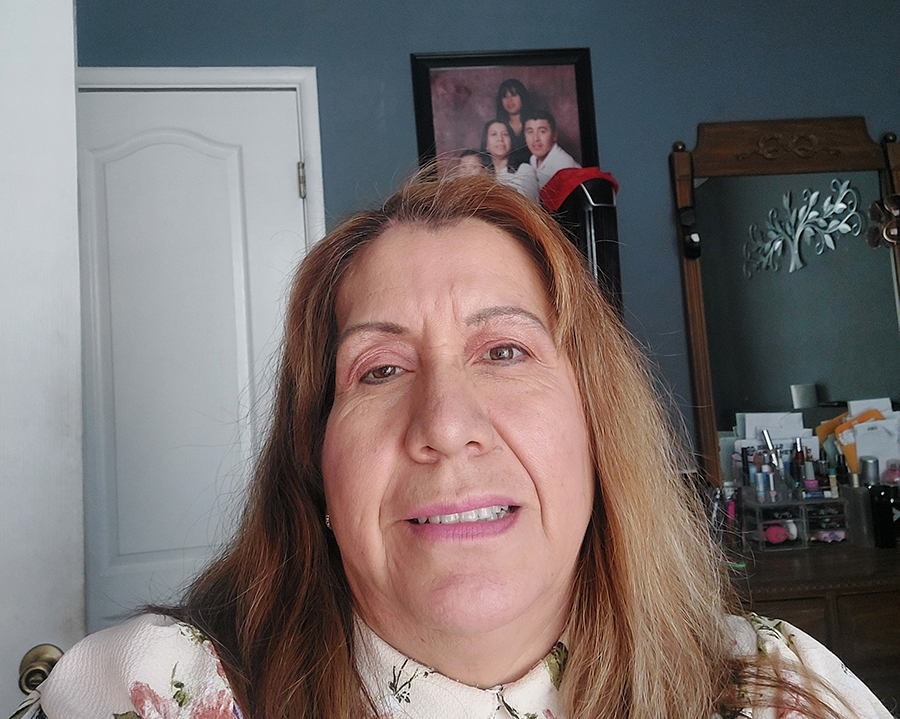Precision Medicine Approaches to Treating Meningiomas

Genomic sequencing is refining how UCSF physicians approach caring for patients with recurrent meningiomas
Maria Arvizu had noticed that she was feeling dizzy and forgetting things more often. She was also getting headaches more frequently, which she thought were just migraines. But the pain would not respond to medication.
Then one day she spiked a high fever and had to be taken to the emergency room. An MRI revealed that she had a meningioma, the most common type of brain tumor.
She underwent surgery to remove most of the tumor and started getting MRI scans every six months to monitor for disease progression. But, three years later in 2017, she was told that she needed to have another surgery because her tumor had grown back significantly.
“I was feeling desperate at the thought of another surgery, but I thought ‘Hopefully, this will be the last time!’” she said. “But no, it happened again.”
Over the next five years, Maria would face multiple recurrences before a new approach brought a chance for remission.
Not always “low-risk” brain tumors
Approximately 42,000 Americans are diagnosed with meningiomas every year. Most of these are slow-growing tumors and because they respond well to the currently available treatments of surgery and radiation therapy, physicians consider these “low-risk” meningiomas.
But recent UCSF-led studies analyzing the patterns of gene expression in meningiomas show that about 20 percent of grade 1 tumors like Maria’s recur. These investigations suggest that integrating more of the genomic features of these tumors into the current World Health Organization classification scheme could improve how the disease is managed.
Recurrences are also more likely to be more aggressive. In Maria’s case, her third recurrence – eight years after her initial diagnosis in 2014 – had progressed to a grade 2 atypical meningioma based on what it looked like under a microscope.
Sequencing with the UCSF500 Cancer Gene Panel revealed that the tumor had a high number of mutations, indicating that it might be more likely to respond to immunotherapy.
This is because hypermutated tumors often have more immune cells in their microenvironment that can be activated by treatments like immune checkpoint inhibitors.
“The tumor was indeed chockfull of immune cells, which was very much in contrast to normal meningiomas,” said UCSF physician-scientist David Raleigh, MD, PhD.

Despite another surgery, the tumor still grew back within four months, requiring a fifth operation. Another sequencing test showed it remained a grade 2 atypical meningioma with a similar genomic profile.
By that point, her neuro-oncologist Nancy Ann Oberheim Bush, MD, PhD, had launched a phase II clinical trial for patients with recurrent meningioma, and Maria was able to enroll. She received stereotactic radiosurgery as well as three infusions of the immune checkpoint inhibitor pembrolizumab.
The medication made her feel dizzy, but the tumor finally responded to this combination therapy. The residual tumor left after surgery was significantly smaller three months after starting the immunotherapy and continued to shrink over the following three months.
Oberheim Bush says that Maria continues to be doing well – now more than a year out from the treatment.
“These are not always benign tumors, but it’s difficult to predict which ones will be resistant to standard treatments,” she said. “Understanding their genomic features is helping us stratify patients into more accurate prognostic groups and revealing new vulnerabilities that we can target.”

A New Multidisciplinary Meningioma Clinic
The complete response of Maria’s tumor to the immunotherapy was likely due to its unique molecular features.
“While this is a very small percentage of the pie – perhaps 2 percent of meningiomas – it’s still very encouraging for a tumor with no effective medical therapies,” Raleigh said.
Her case was recently published in Neuro-Oncology Advances and underscores the importance of using genomics to inform treatment plans tailored to each individual patient.
At UCSF, all patients with meningioma now have their tumor sequenced after surgery. A multidisciplinary team of physicians and nurses then convene a “tumor board” meeting to review all the information about each patient’s tumor and determine the most appropriate treatment options.
As for Maria, she’s glad to be back to having a more active lifestyle, doing the things she enjoys. She goes shopping and for walks at a small park near her home in the East Bay.
“I feel like a weight has been lifted off me now that I feel better,” she said.